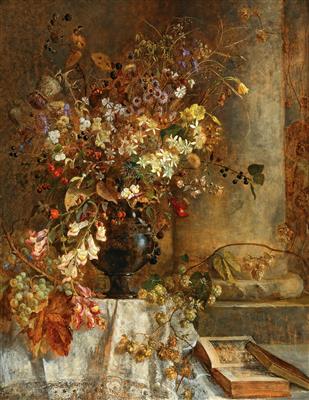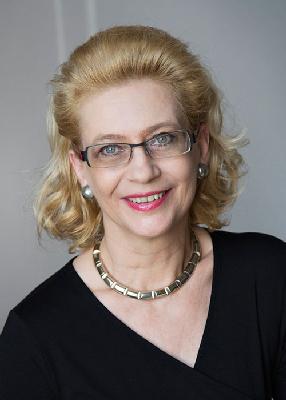Marie Egner

(Radkersburg 1850–1940 Maria Anzbach)
“Altweibersommer” [Indian summer], on the reverse titled in handwriting and inscribed M. Egner, signed M. Egner, oil on panel, 73 x 57 cm, framed (frame slightly damaged), (Rei)
Künstlerhaus label 1884, 765 listed by Dr. Wladimir Aichelburg, 150 Jahre Künstlerhaus Wien 1861-2011 (www.wladimir-aichelburg.at/kuesntlerhaus)
Provenance:
Private Collection, Austria.
Evidence of a strong sensitivity to the colours and lighting ambience of nature can already be found in Marie Egner’s early diary entries, although it was only from the 1870s onwards that she turned more strongly to drawing and painting. As the daughter of a forester in Styria, she developed a love of nature in her parents’ home. In 1872-75 she received her training in oil painting from the landscape painter Carl Jungheim in Düsseldorf.
Back in Vienna, Marie Egner exhibited with some success as early as the second half of the 1870s, specifically seeking contact with contemporary fellow artists in order to become better acquainted with their painting. Impressed by the works of the French Barbizon School, which were shown at the Vienna World’s Fair in 1873, Emil Jakob Schindler found similar motifs and moods in the Prater and around Vienna. From the 1880s a circle of students gathered around Schindler, including Olga Wiesinger-Florian and Carl Moll as well as Marie Egner. In retrospect, she viewed her time with Schindler as a crucial impetus for her own development, although later she found a quieter, softer style. She won some recognition with her audience with her large flower and fruit still lifes. Here, Egner deliberately uses backgrounds that are self-designed and yet make contrasts visible. The arrangement of the flowers in the present lot looks relaxed and atmospheric despite a well-balanced composition. The roundish flowers of the snapdragon and the blue bellflowers represent the last blooms of summer, while the dry thistles and ripening berries evoke the autumn. The title ‘Altweibersommer’ (‘Indian Summer’), which she wrote in her own hand on the reverse, sums up this tension between climax and transience.
Expert: Mag. Dimitra Reimüller
 Mag. Dimitra Reimüller
Mag. Dimitra Reimüller
+43-1-515 60-355
19c.paintings@dorotheum.at
29.04.2019 - 17:00
- Dosažená cena: **
-
EUR 81.550,-
- Odhadní cena:
-
EUR 40.000,- do EUR 60.000,-
Marie Egner
(Radkersburg 1850–1940 Maria Anzbach)
“Altweibersommer” [Indian summer], on the reverse titled in handwriting and inscribed M. Egner, signed M. Egner, oil on panel, 73 x 57 cm, framed (frame slightly damaged), (Rei)
Künstlerhaus label 1884, 765 listed by Dr. Wladimir Aichelburg, 150 Jahre Künstlerhaus Wien 1861-2011 (www.wladimir-aichelburg.at/kuesntlerhaus)
Provenance:
Private Collection, Austria.
Evidence of a strong sensitivity to the colours and lighting ambience of nature can already be found in Marie Egner’s early diary entries, although it was only from the 1870s onwards that she turned more strongly to drawing and painting. As the daughter of a forester in Styria, she developed a love of nature in her parents’ home. In 1872-75 she received her training in oil painting from the landscape painter Carl Jungheim in Düsseldorf.
Back in Vienna, Marie Egner exhibited with some success as early as the second half of the 1870s, specifically seeking contact with contemporary fellow artists in order to become better acquainted with their painting. Impressed by the works of the French Barbizon School, which were shown at the Vienna World’s Fair in 1873, Emil Jakob Schindler found similar motifs and moods in the Prater and around Vienna. From the 1880s a circle of students gathered around Schindler, including Olga Wiesinger-Florian and Carl Moll as well as Marie Egner. In retrospect, she viewed her time with Schindler as a crucial impetus for her own development, although later she found a quieter, softer style. She won some recognition with her audience with her large flower and fruit still lifes. Here, Egner deliberately uses backgrounds that are self-designed and yet make contrasts visible. The arrangement of the flowers in the present lot looks relaxed and atmospheric despite a well-balanced composition. The roundish flowers of the snapdragon and the blue bellflowers represent the last blooms of summer, while the dry thistles and ripening berries evoke the autumn. The title ‘Altweibersommer’ (‘Indian Summer’), which she wrote in her own hand on the reverse, sums up this tension between climax and transience.
Expert: Mag. Dimitra Reimüller
 Mag. Dimitra Reimüller
Mag. Dimitra Reimüller
+43-1-515 60-355
19c.paintings@dorotheum.at
|
Horká linka kupujících
Po-Pá: 10.00 - 17.00
kundendienst@dorotheum.at +43 1 515 60 200 |
| Aukce: | Obrazy 19. století |
| Typ aukce: | Salónní aukce |
| Datum: | 29.04.2019 - 17:00 |
| Místo konání aukce: | Wien | Palais Dorotheum |
| Prohlídka: | 20.04. - 29.04.2019 |
** Kupní cena vč. poplatku kupujícího a DPH
Není již možné podávat příkazy ke koupi přes internet. Aukce se právě připravuje resp. byla již uskutečněna.
